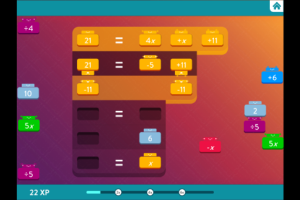


Borough of Manhattan Community College Mathematics Professor Kathleen Offenholley is a math games maven. She sees art and playfulness in math and has long used hands-on games of her own creation in her courses as a vehicle to raise students’ interest in math.
“I find that especially for anxious students, games can take students out of their anxiety,” she said.
Educators can now access the three open-source digital games at Math Games for STEM, which she worked with professional game developers to create for the gatekeeper algebra course that STEM majors take at the Borough of Manhattan Community College.
The games are xPonum – a puzzle game; Algebots – an equation-solving game; and The Project Sampson – an adventure and resource management game. “In all three, the math is intrinsic to the puzzle,” Offenholley said. Download the free games and educator guides at https://mathgamesforstem.wordpress.com/
Offenholley said the games were extremely effective when tested in a summer immersion program for in-coming geographic information systems (GIS) majors, who were the focus of her ATE project: Simulation-Based Curriculum to Accelerate Math Remediation and Improve Degree Completion for STEM Majors (Award # 1501499). The free algebra textbook that she and colleagues also developed for this project is at math56oer.wordpress.com.
Offenholley has found that games are effective for teaching math concepts because the positive emotions that generally accompany game-playing experiences pull students in and reduce their aversion to doing math.
“Even if you are mad at math, and you hate math and you have all these negative associations around math, which some of my students do – even the STEM majors – when you play a game, you have happy associations about games. So it really makes a huge difference. My students will put up with things in a game that they would not put up with in a classroom,” she said.
For example, she said her students get excited to compete against each other to figure out the correct number and types of coins in a sealed envelope when the only clue is that the number of quarters is five times more than another coin in the envelope.
“I don’t want to say that we have to make math more appealing. That’s not it. We need to show people how appealing math already is. Right? Math is appealing. It is fun. But me saying that is not going to do anything,” she said during a recent Zoom interview.
She recommends that faculty introduce the three digital algebra games by having students play them for about 30 minutes during class. In this way instructors can interact with students while they explore the math in the games and then debrief afterward by having students talk about what they learned.
Offenholley provided the three game designers with detailed information about the course objectives and the concepts that the games needed to cover. xPonum was designed by Neuronic Games; Algebots was designed by Bumblebear Games; and Project Samson was designed by Electric Funstuff;
Each of the designers took a different approach. Consequently, each is “very explorational” and distinct.
“So you’re not just following a set of rules, you’re exploring how what you do affects the math. It’s very much about exploring, and a lot of times that’s hard to do in a math class, to allow time to explore. And yet that’s the thing that often makes students come back to math – feeling like they have agency. And so ideally you would use one of the games for half an hour in the class, not as homework but in the class, because then you can talk immediately about what the students discovered,” she said.
Offenholley advocates for all three games, and several of her colleagues in the CUNY Games Network have adopted for math and courses in other disciplines. But as “a puzzle game person” Offenholley has a favorite: xPonum.
“xPonum is so beautiful. You could pick up without understanding a lot of what you are doing and just try stuff out,” she said.
Algebots has robots that cheer when equations are solved and that start to snore if players don't move them around.
Project Sampson is especially good for GIS students because it is an adventure game that covers geographic concepts while players “fly” to locations to save the planet from disasters.
For a detailed overview of each game, see Offenholley’s presentation at the 2020 ATE Virtual Conference at https://aacc-ate.conferencecontent.net/sessions/D03

 Subscribe
Subscribe


 See More ATE Impacts
See More ATE Impacts

Comments
There are no comments yet for this entry. Please Log In to post one.